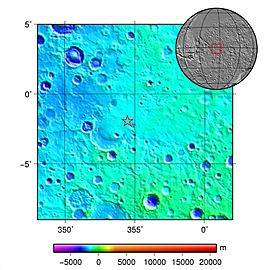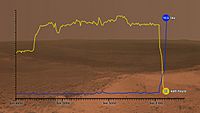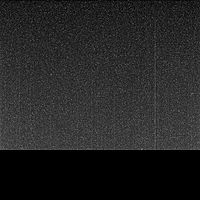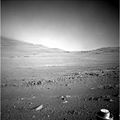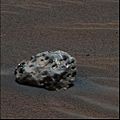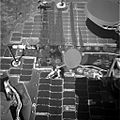Opportunity (rover) facts for kids
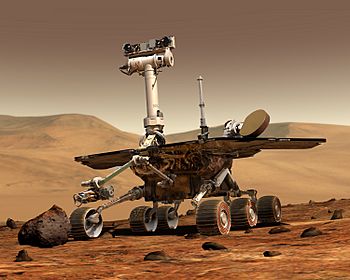
An artist's portrayal of Opportunity on the surface of Mars.
|
|
| Mission type | Mars rover |
|---|---|
| Operator | NASA |
| Mission duration | Planned: 90 sols (92.5 Earth days) Actual: 5,352 sols (8 Mars years), 5,498 days (15 Earth years) |
| Spacecraft properties | |
| Spacecraft type | Rover |
| Launch mass | Total: 1,063 kg
|
| Start of mission | |
| Launch date | July 8, 2003, 03:18 UTC |
| Rocket | Delta II 7925H-9.5 |
| Launch site | Cape Canaveral SLC-17B |
| Contractor | Boeing |
| End of mission | |
| Declared | February 13, 2019 |
| Last contact | June 10, 2018 |
| Mars rover | |
| Landing date | January 25, 2004, 05:05 UTC SCET MSD 46236 14:35 AMT |
| Landing site | 1°56′46″S 354°28′24″E / 1.9462°S 354.4734°E Eagle, Meridiani Planum |
| Distance covered | 45.16 km (28.06 mi) |
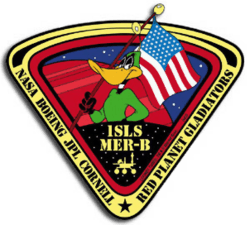 The launch patch for Opportunity, featuring Duck Dodgers (Daffy Duck) NASA Mars rovers
|
|
Opportunity, also known as MER-B (Mars Exploration Rover – B) or MER-1, and nicknamed Oppy, is a robotic rover that was active on Mars from 2004 until mid-2018. Opportunity was operational on Mars for 5110 sols (5250 days). Launched on July 7, 2003, as part of NASA's Mars Exploration Rover program, it landed in Meridiani Planum on January 25, 2004, three weeks after its twin Spirit (MER-A) touched down on the other side of the planet. With a planned 90-sol duration of activity (slightly less than 92.5 Earth days), Spirit functioned until it got stuck in 2009 and ceased communications in 2010, while Opportunity was able to stay operational for 5111 sols after landing, maintaining its power and key systems through continual recharging of its batteries using solar power, and hibernating during events such as dust storms to save power. This careful operation allowed Opportunity to operate for 57 times its designed lifespan, exceeding the initial plan by 14 years, 46 days (in Earth time). By June 10, 2018, when it last contacted NASA, the rover had traveled a distance of 45.16 kilometers (28.06 miles).
Mission highlights included the initial 90-sol mission, finding meteorites such as Heat Shield Rock (Meridiani Planum meteorite), and over two years of exploring and studying Victoria crater. The rover survived moderate dust storms and in 2011 reached Endeavour crater, which has been described as a "second landing site." The Opportunity mission is considered one of NASA's most successful ventures.
Due to the planetary 2018 dust storm on Mars, Opportunity ceased communications on June 10 and entered hibernation on June 12, 2018. It was hoped it would reboot once the weather cleared, but it did not, suggesting either a catastrophic failure or that a layer of dust had covered its solar panels. NASA hoped to re-establish contact with the rover, citing recurring windy period, forecast for November 2018 to January 2019, that could potentially clean off its solar panels. On February 13, 2019, NASA officials declared that the Opportunity mission was complete, after the spacecraft had failed to respond to over 1,000 signals sent since August 2018.
Mission overview
Collectively, the Opportunity and Spirit rovers were part of the Mars Exploration Rover program in the long-term Mars Exploration Program. The Mars Exploration Program's four principal goals were to determine if the potential for life exists on Mars (in particular, whether recoverable water may be found on Mars), to characterize the Mars climate and its geology, and then to prepare for a potential human mission to Mars. The Mars Exploration Rovers were to travel across the Martian surface and perform periodic geologic analyses to determine if water ever existed on Mars as well as the types of minerals available, as well as to corroborate data taken by the Mars Reconnaissance Orbiter (MRO). Spirit and Opportunity were launched a month apart, on June 10 and July 7, 2003, and both reached the Martian surface by January 2004. Both rovers were designed with an expected 90 sols (92 Earth days) lifetime, but each lasted much longer than expected. Spirit's mission lasted 20 times longer than its expected lifetime, and its mission was declared ended on May 25, 2011, after it got stuck in soft sand and expended its power reserves trying to free itself. Opportunity lasted 55 times longer than its 90 sol planned lifetime, operating for 5498 days from landing to mission end. An archive of weekly updates on the rover's status can be found at the Opportunity Update Archive.
From its initial landing, by chance, into an impact crater amidst an otherwise generally flat plain, Opportunity successfully investigated regolith and rock samples and took panoramic photos of its landing site. Its sampling allowed NASA scientists to make hypotheses concerning the presence of hematite and past presence of water on the surface of Mars. Following this, it was directed to travel across the surface of Mars to investigate another crater site, Endurance crater, which it investigated from June to December 2004. Subsequently, Opportunity examined the impact site of its own heat shield and discovered an intact meteorite, now known as Heat Shield Rock, on the surface of Mars.
From late April to early June 2005, Opportunity was perilously lodged in a sand dune, with several wheels buried in the sand. Over a six-week period, Earth-based physical simulations were performed to decide how best to extract the rover from its position without risking its permanent immobilization. Successful maneuvering a few centimeters at a time eventually freed the rover, which resumed its travels.
Opportunity was directed to proceed in a southerly direction to Erebus crater, a large, shallow, partially buried crater and a stopover on the way south towards Victoria crater, between October 2005 and March 2006. It experienced some mechanical problems with its robotic arm.
In late September 2006, Opportunity reached Victoria crater and explored along the rim in a clockwise direction. In June 2007 it returned to Duck Bay, its original arrival point at Victoria crater; in September 2007 it entered the crater to begin a detailed study. In August 2008, Opportunity left Victoria crater for Endeavour crater, which it reached on August 9, 2011.
Here at the rim of the Endeavour crater, the rover moved around a geographic feature named Cape York. The Mars Reconnaissance Orbiter had detected phyllosilicates there, and the rover analyzed the rocks with its instruments to check this sighting on the ground. This structure was analyzed in depth until summer 2013. In May 2013 the rover was heading south to a hill named Solander Point.
Opportunity's total odometry by June 10, 2018 (sol 5111), was 45.16 km (28.06 mi), while the dust factor was 10.8. Since January 2013, the solar array dust factor (one of the determinants of solar power production) varied from a relatively dusty 0.467 on December 5, 2013 (sol 3507), to a relatively clean 0.964 on May 13, 2014 (sol 3662).
In December 2014, NASA reported that Opportunity was suffering from "amnesia" events in which the rover failed to write data, e.g. telemetry information, to non-volatile memory. The hardware failure was believed to be due to an age-related fault in one of the rover's seven memory banks. As a result, NASA had aimed to force the rover's software to ignore the failed memory bank; amnesia events continued to occur, however, which eventually resulted in vehicle resets. In light of this, on Sol 4027 (May 23, 2015), the rover was configured to operate in RAM-only mode, completely avoiding the use of non-volatile memory for storage.
End of mission
In early June 2018, a large planetary-scale dust storm developed, and within a few days the rover's solar panels were not generating enough power to maintain communications, with the last contact on June 10, 2018. NASA stated that they did not expect to resume communication until after the storm subsided, but the rover kept silent even after the storm ended in early October, suggesting either a catastrophic failure or a layer of dust covering its solar panels. The team remained hopeful that a windy period between November 2018 and January 2019 might clear the dust from its solar panels, as had happened before. Wind was detected nearby on January 8, and on January 26 the mission team announced a plan to begin broadcasting a new set of commands to the rover in case its radio receiver failed.
On February 12, 2019, past and present members of the mission team gathered in JPL's Space Flight Operations Facility to watch final commands being transmitted to Opportunity via the 70 meter dish of the Goldstone Deep Space Communications Complex in California. Following 25 minutes of transmission of the final 4 sets of commands, communication attempts with the rover were handed off to Canberra, Australia.
More than 835 recovery commands were transmitted since losing signal in June 2018 to the end of January 2019 with over 1000 recovery commands transmitted before February 13, 2019. NASA officials held a press conference on February 13 to declare an official end to the mission. NASA associate administrator Thomas Zurbuchen said, "It is therefore that I am standing here with a deep sense of appreciation and gratitude that I declare the Opportunity mission is complete." As NASA ended their attempts to contact the rover, the last data sent was the song "I'll Be Seeing You" performed by Billie Holiday. Assets that had been needed to support Opportunity were transitioned to support the Mars rovers Curiosity and Perseverance.
The final communication from the rover came on June 10, 2018 (sol 5111) from Perseverance Valley, and indicated a solar array energy production of 22 Watt-hours for the sol, and the highest atmospheric opacity (tau) ever measured on Mars: 10.8.
Images for kids
-
Opportunity rover "off-world" driving distance record, compared to other rovers. Dashed grey vertical bar represents the Marathon distance of 42.195 km
See also
 In Spanish: Opportunity para niños
In Spanish: Opportunity para niños



